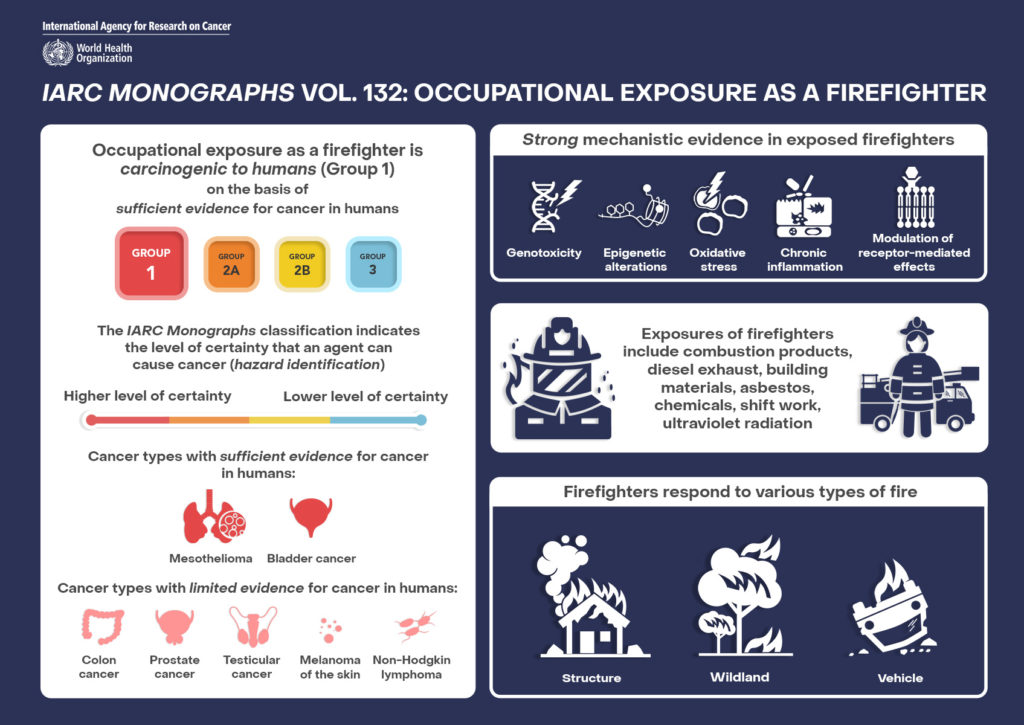
Authors
- Judith M Graber, PhD, Associate Professor of Epidemiology, Department of Biostatistics & Epidemiology, Rutgers School of Public Health
- Antoinette M Stroup, PhD, Professor of Epidemiology, Department of Biostatistics & Epidemiology, Rutgers School of Public Health; Director, New Jersey State Cancer Registry
This determination was based on sufficient epidemiological evidence.
In June of 2022, the International Agency for Research on Cancer (IARC) classified occupational exposure as a firefighter as carcinogenic to humans (Group 11).
There are more than 15 million firefighters worldwide2 and approximately 1.1 million firefighters in the United States.3
The IARC Working Group, which comprised of 25 scientists from eight countries, made this determination based on sufficient epidemiological evidence for a causal association between occupation as a firefighter and both mesothelioma and bladder cancer.
The IARC Working Group also cited strong mechanistic evidence for the association.1 This evidence found that firefighting shows the following key characteristics of carcinogens: the ability to induce epigenetic alterations, oxidative stress, chronic inflammation, and genotoxicity, as well as to modulate receptor-mediated effects (specifically activation of the aryl hydrocarbon receptor that can increase cancer risk).1
Additional Findings for Firefighters
The Working Group found limited evidence of a causal association for melanoma of the skin, non-Hodgkin lymphoma (NHL), as well as cancers of the colon, prostate, and testes.1 “Limited evidence” in this context means that while there was a credible positive association, they could not rule out the influence of potential confounding by other factors such as other jobs or lifestyle factors; they could not eliminate the potential for bias, particularly that some cancers might be detected early through medical surveillance; and, that the current evidence was based on studies with inconsistent or statistically unstable findings.
The Working Group’s review included 52 cohort and case-control studies, 12 case reports, and seven meta-analyses.1 Many of these studies relied on linkages with population-based cancer registries to ascertain cancer incidence.4-10 For population-based cancer registries in the U.S. and around the world, the IARC determination is an example of the important role of cancer registries and how data from cancer registries support research.
Importantly, these findings apply to all firefighters, including any type of career or volunteer who have prepared for and taken part in fire control activities. These findings reinforce the need to reduce cancer risk across the fire service.
References
- Demers, P.A., et al., Carcinogenicity of occupational exposure as a firefighter. Lancet Oncol, 2022. 23(8): p. 985-986.
- Brushlinsky, N., Ahrens, M., Sokolov, S., Wagner, I. G. World Fire Statistics.
- Fahy R., E., B., Stein, GP., U.S. Fire Department Profile 2019. National Fire Protection Association (NFPA); Research., 2021.
- Marjerrison, N., et al., Comparison of cancer incidence and mortality in the Norwegian Fire Departments Cohort, 1960-2018. Occup Environ Med, 2022.
- Sritharan, J., et al., Cancer risk among firefighters and police in the Ontario workforce. Occup Environ Med, 2022. 79(8): p. 533-539.
- Daniels, R.D., et al., Mortality and cancer incidence in a pooled cohort of U.S. firefighters from San Francisco, Chicago and Philadelphia (1950-2009). Occup Environ Med, 2014. 71(6): p. 388-97.
- Glass, D.C., et al., Mortality and cancer incidence among female Australian firefighters. Occup Environ Med, 2019. 76(4): p. 215-221.
- Glass, D.C., et al., Mortality and cancer incidence among male volunteer Australian firefighters. Occup Environ Med, 2017. 74(9): p. 628-638.
- Glass, D.C., et al., Mortality and cancer incidence in a cohort of male paid Australian firefighters. Occup Environ Med, 2016. 73(11): p. 761-771.
- Bigert, C., et al., Lung Cancer Among Firefighters: Smoking-Adjusted Risk Estimates in a Pooled Analysis of Case-Control Studies. J Occup Environ Med, 2016. 58(11): p. 1137-1143.
How can this latest classification help firefighters?
Tags: firefighters
What to Read Next
NAACCR Launches New Interoperability Resources Webpage
Streamline your understanding of interoperability in healthcare, public health, and research with NAACCR’s new webpage. Find links to standards, policies,…
NAACCR Surgery Code Crosswalks Enable Analysis Over Time
Submitted on behalf of the NAACCR Surgery Code Crosswalk Task Force Background If you are familiar with cancer registry operations,…
Beyond Definition: First Annual Catchment Area Data Conference
In early December, NCI sponsored the first conference of its kind—the Catchment Area Data Conference – Beyond Definition, hosted by…





